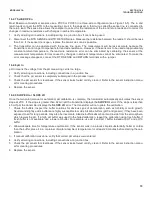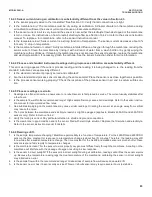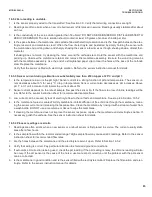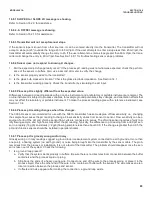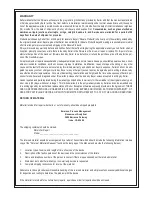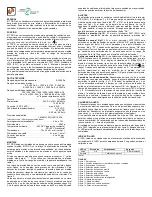
92
MODEL 5081-A
SECTION 16.0
TROUBLESHOOTING
16.11 SIMULATING INPUTS - pH
16.11.1 General
This section describes how to simulate a pH input into the transmitter. To simulate a pH measurement, connect a standard
millivolt source to the transmitter. If the transmitter is working properly, it will accurately measure the input voltage and con-
vert it to pH. Although the general procedure is the same, the wiring details depend on whether the preamplifier is in the
sensor, a junction box, or the transmitter.
16.11.2 Simulating pH input when the preamplifier is in the analyzer.
1. Turn off automatic temperature correction and set the manual temperature to 25°C (Section 7.4).
2. Disconnect the pH sensor. Also, disconnect the chlorine sensor anode lead. Connect a jumper wire between the pH IN
and REF IN terminals.
3. Confirm that the transmitter is reading the correct mV value. With the main display showing, press DIAG. Press NEXT
until the display shows
PH
. Press ENTER. The display will show
InPUt
followed by a number. The number is the raw
input signal in millivolts. The measured voltage should be 0 mV.
4. Confirm that the transmitter is reading the correct pH value. Go to the main display. Press
é
or
ê
. The second line of
the display will show the pH. The pH should be approximately 7.00. Because calibration data stored in the analyzer
may be offsetting the input voltage, the displayed pH may not be exactly 7.00.
5. If a standard millivolt source is available, disconnect the jumper wire between the pH IN and REF IN terminals and
connect the voltage source as shown in Figure 16-3.
6. Calibrate the transmitter using the procedure in Section 13.3. Use 0.0 mV for Buffer 1 (pH 7.00) and -177.4 mV for
Buffer 2 (pH 10.00). If the analyzer is working properly, it should accept the calibration. The slope should be 59.16 mV/pH,
and the offset should be zero.
7. To check linearity, set the voltage source to the values shown in the table and verify that the pH and millivolt readings
match the values in the table.
FIGURE 16-3. Simulate pH.
16.11.3 Simulating pH input when the preamplifier is in a junction box.
The procedure is the same as described in section 16.11.2. Keep the connection between the analyzer and the junction
box in place. Disconnect the sensor at the sensor side of the junction box and connect the voltage source to the sensor
side of the junction box.
16.11.4 Simulating pH input when the preamplifier is in the sensor.
The preamplifier in the sensor converts the high impedance signal into a low impedance signal without amplifying it. To
simulate pH values, follow the procedure in Section 16.11.2.
voltage (mv)
pH (at 25°)
295.8
2.00
177.5
4.00
59.2
6.00
59.2
8.00
177.5
10.00
295.8
12.00
Summary of Contents for Rosemount Analytical HART 5081-A-HT
Page 22: ...FIGURE 4 2 FM Intrinsically Safe Installation Label 16 ...
Page 25: ...FIGURE 4 4 CSA Intrinsically Safe Installation Label 19 ...
Page 26: ...FIGURE 4 5 CSA Intrinsically Safe Installation 1 of 2 20 ...
Page 27: ...FIGURE 4 5 CSA Intrinsically Safe Installation 2 of 2 21 ...
Page 108: ...FIGURE 4 Wiring to Model 5081 102 MODEL 4000 WIRING ...
Page 110: ...104 ...


